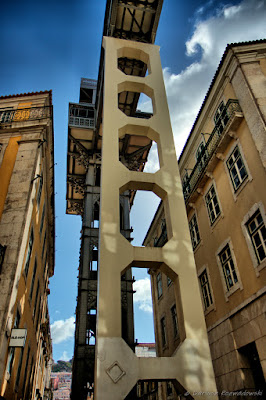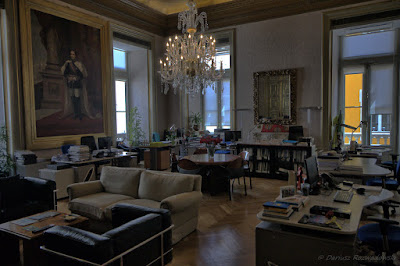Baixa is the historical center of Lisbon, rebuilt after the earthquake in 1755. I suggest a walk around the northern part. Starting from Martim Moniz Square (Praça Martim Moniz), continuing around Rossio Square (Praça Dom Pedro IV), where we can easily find examples of neoclassical architecture around. It is also worth visiting the nearby Restauradores Square (Praça dos Restauradores). The squares strongly emphasize the struggle for independence of Portugal whether in medieval or modern times.
 |
| Baixa - Teatro Nacional D. Maria II |
Praça Martim Moniz is a square in Lisbon, Portugal. The name comes from Martim Moniz (died 1147), a Portuguese knight and a famous figure in the siege of Lisbon in 1147.
According to legend, Marti Moniz was a knight participating in the Christian invasion, commanded by the Portuguese king Afonso I, during the siege of Lisbon. At one point during the siege of
São Jorge's castle (the Reconquest), Martim Moniz saw the Moors closing the castle door. He led the attack on the door and devoted himself, putting his own body in this door, preventing the defenders from closing the door completely. This heroic act allowed friends to come and secure the door, which led to the final conquest of the castle. Martim Moniz died in this incident.
 |
| Baixa - Praça Martim Moniz |
 |
| Baixa - Praça Martim Moniz |
Igreja de São Domingos is a church in Lisbon, Portugal, which has been classified as a national monument.
The church began its activities in 1241 and it usually hosted Portuguese royal weddings until the founding of the modern Portuguese Republic in 1910.
The church was almost completely destroyed in the earthquake in 1755. Reconstruction was completed in 1807. In 1959, the church was destroyed again when a fire in the building. In 1994, the church was reopened.
 |
| Baixa - Igreja de São Domingos |
 |
| Baixa - On the way to Largo São Domingos |
 |
| Baixa - Igreja de São Domingos |
 |
| Baixa - Igreja de São Domingos |
 |
| Baixa - Largo São Domingos |
 |
| Baixa - Igreja de São Domingos |
Palácio da Independência(also called Palácio Almada) - a palace from the 15th century It belonged to the Almada family. In this palace, Antão de Almada and 40 conspirators met at the last meeting, which gave rise to the independence of Portugal on December 1, 1640. King of Spain and Portugal, Philip III of Habsburg was overthrown, and Jan IV Happy or Restorer (João IV o Restaurador) he was acclaimed King of Portugal. The enthronement of John IV led to the war with Spain, which ended with the recognition of Portuguese independence only in 1668.
 |
| Baixa - Palácio da Independência |
Ginja is a cherry liqueur that was made in Lisbon, and the small A Ginjinha bar is a traditional place where you can try this strong and sweet alcoholic drink. Ginja is based on fortified wine, which has been saturated with cherries and combined with a huge amount of sugar. Ginja drink is served with or without a cherry filled with alcohol. The Portuguese love this drink because it was a wonderful medicine for "grandparents" for all kinds of illnesses, and this love for this drink was passed on to younger generations. Ginja is the short name of Ginjinha.
 |
| Baixa - A Ginjinha |
 |
| Baixa - A Ginjinha |
Teatro Nacional D. Maria II is a historic theater building in Lisbon.
The theater was built on the north side of Rossio Square in place of the old Palácio dos Estaus. Thanks to the efforts of the poet Almeida Garrett, it was decided to replace the old palace by a modern theater dedicated to Queen Maria II. The building was built between 1842 and 1846, in the style of neoclassical Palladianism architecture according to the design of the Italian architect Fortunato Lodi. The main feature of the facade is the portico with six Ionic columns, reused from the Monastery of St. Francis in Lisbon.
 |
| Baixa - Teatro Nacional D. Maria II |
 |
| Baixa - Teatro Nacional D. Maria II |
The statue was erected on top of a Corinthian column 23 meters high in 1870. The statue of Peter IV (Pedro IV of Rei-Soldado, King of Portugal and Emperor of Brazil) depicts him in the uniform of a general and royal coat, with his head crowned with laurels and holding the Constitutional Card from 1826 in his right hand. At the base of the column, there are four allegorical figures women: Justice, Wisdom, Strength, and Moderation, attributes attributed to the King.
There is an urban legend that the statue at the top of King Pedro IV's Column was originally designed for Emperor Maximilian I of Mexico. When the Mexican emperor was shot in 1867, shortly before the statue was completed, it is said that the statue was subsequently purchased to embellish Rossio Square. Several historians, such as José Augusto, have proved that this urban legend is untrue, pointing to the statue's details that clearly symbolize the King of Portugal, such as the Portuguese coat of arms on the buttons, the collar of the Order of the Tower and the Sword, and the Constitutional Charter of 1826.
 |
| Baixa - Estátua de D. Pedro IV |
 |
| Baixa - Estátua de D. Pedro IV |
 |
| Baixa - Estátua de D. Pedro IV |
 |
| Baixa - Praça Dom Pedro IV / Rossio Square |
 |
| Baixa - View from Praça Dom Pedro IV |
Praça dos Restauradores - a square near Rossio Square. The square was named to celebrate the restoration of Portuguese independence in 1640, after 60 years of Spanish domination. The obelisk in the center of the square, unveiled in 1886, contains the names and dates of the battles during the Spanish-Portuguese war in 1640.
 |
| Baixa - Monumento aos Restauradores |
 |
| Baixa - View from Praça dos Restauradores |
Location:

































































